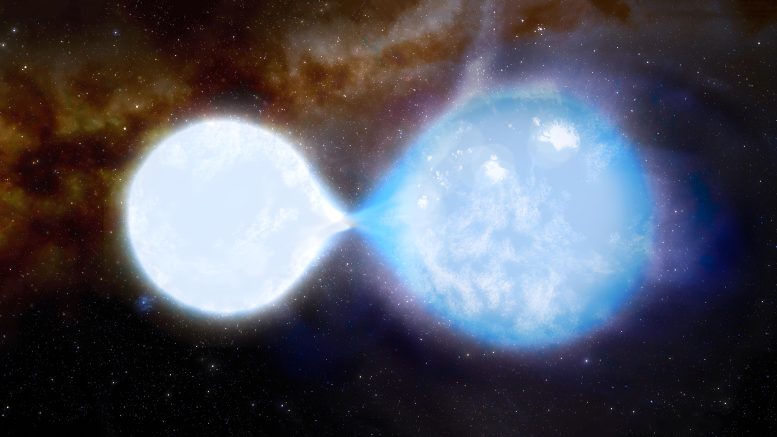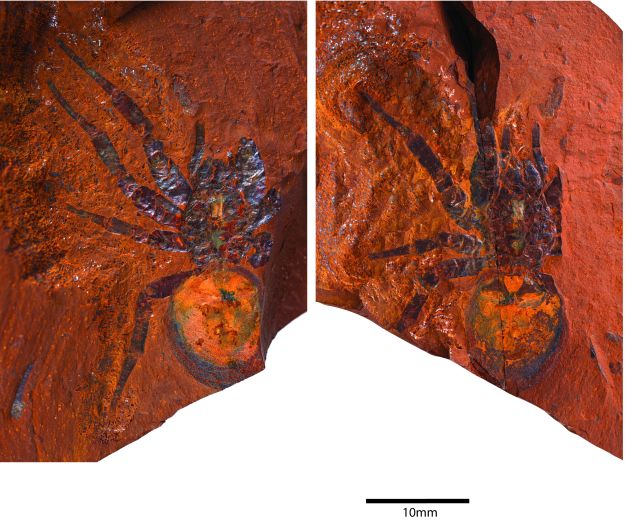
Το μικρότερο, φωτεινότερο και πιο καυτό αστέρι (αριστερά), που έχει μάζα 32 φορές μεγαλύτερη από αυτή του Ήλιου μας, αυτή τη στιγμή χάνει μάζα από τον μεγαλύτερο σύντροφό του (δεξιά), που είναι 55 φορές η μάζα του Ήλιου μας. Τα αστέρια είναι λευκά και μπλε επειδή είναι τόσο καυτά: 43.000 και 38.000 βαθμούς Κέλβιν, αντίστοιχα. Πίστωση: UCL/J.daSilva
Μια νέα μελέτη από ερευνητές στο University College του Λονδίνου και στο Πανεπιστήμιο του Πότσνταμ αποκαλύπτει ότι δύο τεράστια αστέρια επαφής σε έναν γειτονικό γαλαξία είναι καθ’ οδόν για να γίνουν μαύρες τρύπες που τελικά θα συγκρουστούν μεταξύ τους, δημιουργώντας κυματισμούς στον ιστό του χωροχρόνου.
Η μελέτη γίνεται δεκτή για δημοσίευση στο περιοδικό Αστρονομία και αστροφυσικήεξέτασε ένα γνωστό δυαδικό αστέρι (δύο αστέρια που περιφέρονται γύρω από ένα αμοιβαίο κέντρο βάρους) και ανέλυσε το αστρικό φως που προέκυψε από έναν συνδυασμό επίγειων και διαστημικών τηλεσκοπίων.
Οι ερευνητές διαπίστωσαν ότι τα αστέρια, που βρίσκονται σε έναν γειτονικό νάνο γαλαξία που ονομάζεται Μικρό Νέφος του Μαγγελάνου, βρίσκονται σε μερική επαφή και ανταλλάσσουν υλικό μεταξύ τους, με το ένα αστέρι να τρέφεται επί του παρόντος από το άλλο. Περιφέρονται το ένα γύρω από το άλλο κάθε τρεις ημέρες και είναι τα μεγαλύτερα αστέρια επαφής (γνωστά ως δυαδικά στοιχεία επαφής) που έχουν παρατηρηθεί μέχρι σήμερα.
Συγκρίνοντας τα αποτελέσματα των παρατηρήσεών τους με θεωρητικά μοντέλα της εξέλιξης των δυαδικών αστεριών, διαπίστωσαν ότι στο καλύτερο μοντέλο, το αστέρι που τροφοδοτείται αυτή τη στιγμή θα γίνει μαύρη τρύπα και θα τρέφεται από το συνοδό του αστέρι. Το εναπομείναν αστέρι θα γίνει α[{” attribute=””>black hole shortly after.
These black holes will form in only a couple of million years, but will then orbit each other for billions of years before colliding with such force that they will generate gravitational waves – ripples in the fabric of space-time – that could theoretically be detected with instruments on Earth.
PhD student Matthew Rickard (UCL Physics & Astronomy), lead author of the study, said: “Thanks to gravitational wave detectors Virgo and LIGO, dozens of black hole mergers have been detected in the last few years. But so far we have yet to observe stars that are predicted to collapse into black holes of this size and merge in a time scale shorter than or even broadly comparable to the age of the universe.
“Our best-fit model suggests these stars will merge as black holes in 18 billion years. Finding stars on this evolutionary pathway so close to our Milky Way galaxy presents us with an excellent opportunity learn even more about how these black hole binaries form.”
Co-author Daniel Pauli, a PhD student at the University of Potsdam, said: “This binary star is the most massive contact binary observed so far. The smaller, brighter, hotter star, 32 times the mass of the Sun, is currently losing mass to its bigger companion, which has 55 times our Sun’s mass.”
The black holes that astronomers see merge today formed billions of years ago, when the universe had lower levels of iron and other heavier elements. The proportion of these heavy elements has increased as the universe has aged and this makes black hole mergers less likely. This is because stars with a higher proportion of heavier elements have stronger winds and they blow themselves apart sooner.
The well-studied Small Magellanic Cloud, about 210,000 light-years from Earth, has by a quirk of nature about a seventh of the iron and other heavy metal abundances of our own Milky Way galaxy. In this respect, it mimics conditions in the universe’s distant past. But unlike older, more distant galaxies, it is close enough for astronomers to measure the properties of individual and binary stars.
In their study, the researchers measured different bands of light coming from the binary star (spectroscopic analysis), using data obtained over multiple periods of time by instruments on NASA’s Hubble Space Telescope (HST) and the Multi Unit Spectroscopic Explorer (MUSE) on ESO’s Very Large Telescope in Chile, among other telescopes, in wavelengths ranging from ultraviolet to optical to near-infrared.
With this data, the team were able to calculate the radial velocity of the stars – that is, the movement they made towards or away from us – as well as their masses, brightness, temperature and orbits. They then matched these parameters with the best-fit evolutionary model.
Their spectroscopic analysis indicated that much of the outer envelope of the smaller star had been stripped away by its larger companion. They also observed the radius of both stars exceeded their Roche lobe – that is, the region around a star where material is gravitationally bound to that star – confirming that some of the smaller star’s material is overflowing and transferring to the companion star.
Talking through the future evolution of the stars, Rickard explained: “The smaller star will become a black hole first, in as little as 700,000 years, either through a spectacular explosion called a supernova or it may be so massive as to collapse into a black hole with no outward explosion.
“They will be uneasy neighbors for around three million years before the first black hole starts accreting mass from its companion, taking revenge on its companion.”
Pauli, who conducted the modeling work, added: “After only 200,000 years, an instant in astronomical terms, the companion star will collapse into a black hole as well. These two massive stars will continue to orbit each other, going round and round every few days for billions of years.
“Slowly they will lose this orbital energy through the emission of gravitational waves until they orbit each other every few seconds, finally merging together in 18 billion years with a huge release of energy through gravitational waves.”
Reference: “A low-metallicity massive contact binary undergoing slow Case A mass transfer: A detailed spectroscopic and orbital analysis of SSN 7 in NGC 346 in the SMC” by M. J. Rickard and D. Pauli, Accepted, Astronomy & Astrophysics.
DOI: 10.1051/0004-6361/202346055

“Ερασιτέχνης διοργανωτής. Εξαιρετικά ταπεινός web maven. Ειδικός κοινωνικών μέσων Wannabe. Δημιουργός. Thinker.”

